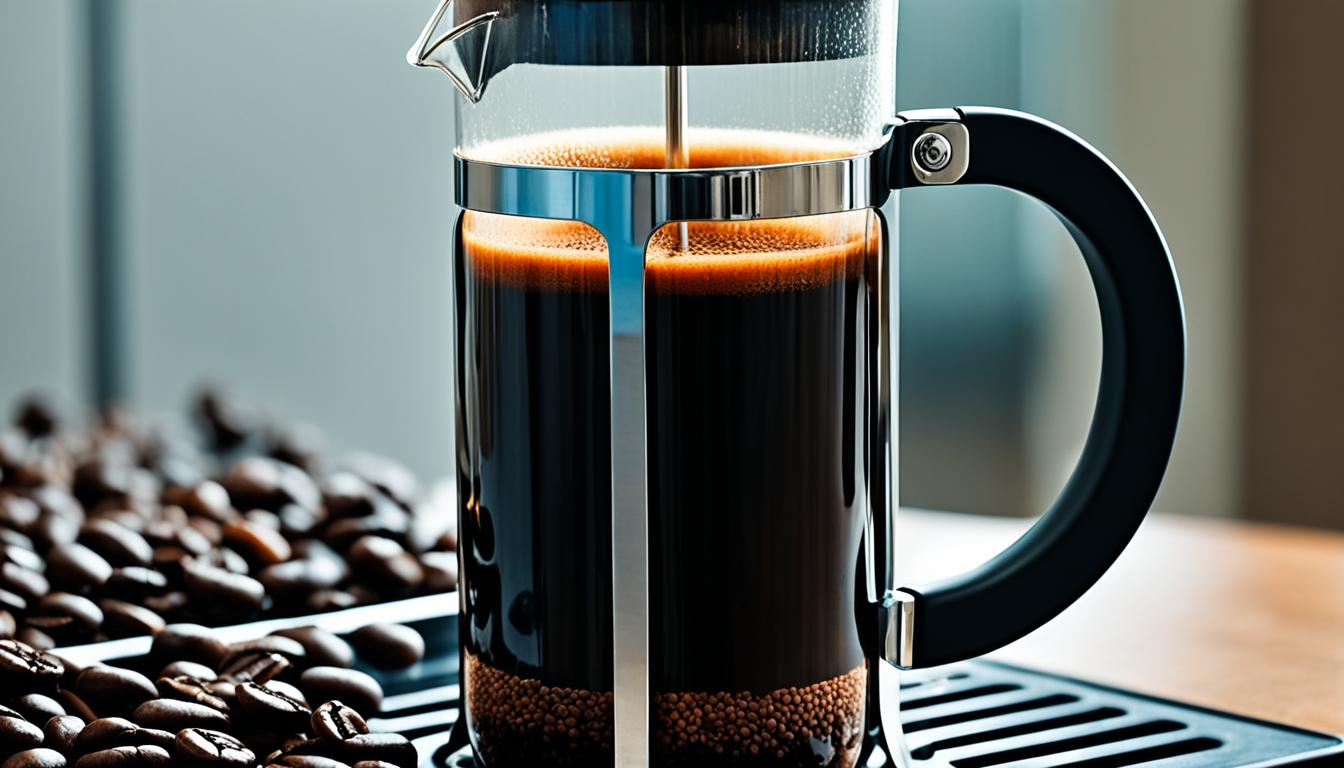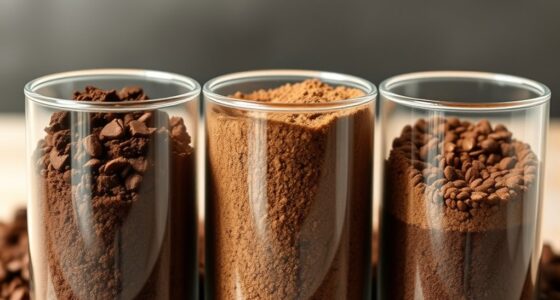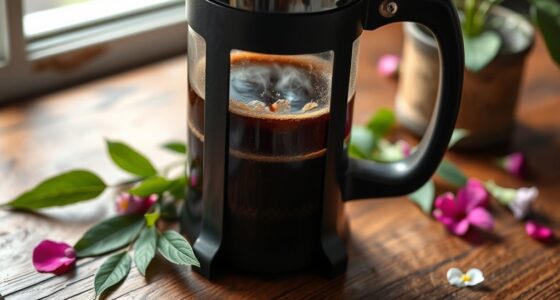Ever pondered the secret behind a French press coffee maker producing that luxurious and flavorful cup of coffee? It’s not just the delightful design or the sophisticated process of handcrafting coffee. There’s a scientific principle behind it, a precise balance of water, coffee, and extraction. So, how exactly does a French press perform its enchanting trick? Let’s delve deeper into the internal mechanics of this cherished manual coffee maker. The French press’s triumph lies in its immersion brewing technique. When hot water and coarsely ground coffee mingle in the French press coffee pot, the outcome is a more intense and full-bodied flavor. The metal filter in the French press allows natural oils and fine particles to seep through, enhancing the coffee’s rich aroma and creamy consistency. The simplicity and efficacy of the French press coffee pot have made it a kitchen essential for many coffee enthusiasts.
Key Takeaways:
- A French press uses a cylindrical carafe, a plunger, and a built-in filter to create delicious coffee.
- Ground coffee is immersed in hot water, allowing its flavors and oils to infuse.
- Pressing down the filter separates the coffee grounds, resulting in a full-bodied cup of coffee.
- French press coffee may contain substances that can potentially impact cholesterol levels.
- Understanding how a French press works can enhance your appreciation for this brewing method.
Pros and Cons of Using a French Press
A French press coffee maker offers a unique brewing experience with its rich, full-bodied flavors. However, like any brewing method, using a French press comes with its own set of pros and cons.
Pros
- Easy usability and clean-up: A French press is straightforward to use, requiring minimal steps to brew a delicious cup of coffee. Cleaning the French press is also hassle-free, as it only involves rinsing and removing the used coffee grounds.
- Relatively low cost: French press coffee makers are affordable compared to more complex brewing methods, making them a budget-friendly option for coffee enthusiasts.
- Small footprint: French press coffee makers are compact and don’t take up much space on kitchen countertops, making them ideal for individuals with limited space.
- Versatile brewing options: In addition to brewing coffee, French presses can also be used to steep loose-leaf tea or make cold brew, adding versatility to this brewing device.
Cons
- Additional equipment required: To brew coffee using a French press, you may need to invest in additional equipment such as a coffee grinder, kettle, scale, and thermometer to ensure optimal brewing conditions.
- Monitoring variables: Achieving the perfect cup of French press coffee requires monitoring various variables, including water temperature, coffee grind size, and brewing time, making it a less intuitive process compared to other brewing methods.
- Immediate serving: French press coffee is best enjoyed immediately after brewing to prevent over-extraction. Unlike other brewing methods where the coffee can be kept warm or reheated, French press coffee should be consumed promptly.
- Health considerations: French press coffee may contain oils that can impact cholesterol levels, but research suggests that moderation is key. Enjoying French press coffee in moderation should not significantly impact cholesterol levels.
Despite these considerations, many coffee enthusiasts appreciate the robust flavor and unique brewing experience that a French press coffee maker offers. Understanding the pros and cons can help individuals make an informed decision when choosing their preferred brewing method.
What You Need to Make French Press Coffee
To make delicious French press coffee, you’ll need a few key ingredients and equipment. Let’s take a closer look at what you’ll need:
Ingredients:
- Filtered water: Using filtered water will ensure a clean and pure taste in your coffee.
- High-quality coffee beans: Look for beans with flavor profiles that suit your taste preferences, such as French roast, smooth, full-bodied, or any other profiles that pique your interest.
Equipment:
- Coffee grinder: Grinding your own coffee beans just before brewing ensures freshness and allows you to control the grind size.
- Kettle: A kettle is necessary to boil water to the ideal temperature for French press coffee.
- Scale or coffee scoop: Using a scale provides consistency in measuring the coffee, but a coffee scoop can also be used to measure the desired amount accurately.
- Thermometer: Monitoring the water temperature is essential for optimal coffee extraction. A thermometer helps ensure the water is at the recommended temperature of around 200ºF.
With these ingredients and equipment ready, you’ll be well-prepared to brew a delicious cup of French press coffee.
Caption: The essential ingredients and equipment for making French press coffee.
How to Brew Coffee Using a French Press
Follow these easy steps to brew a delicious cup of coffee using a French press:
- Step 1: Heat water to around 200ºF. This is the optimal temperature for extracting the full flavor of the coffee.
- Step 2: Add coarse-ground coffee to the carafe. The recommended coffee-to-water ratio is 1:15, which means for every 1 gram of coffee, you’ll need 15 grams of water.
- Step 3: Slowly pour the hot water over the coffee, ensuring that all the grounds are evenly saturated. Start by adding a small amount of water, allowing the coffee to bloom and release its flavors.
- Step 4: Allow the coffee to steep for four minutes. This steeping time allows for optimal extraction and ensures a robust and flavorful cup of coffee.
- Step 5: Break the crust that forms on top using a wooden spoon. This helps release any trapped gases and ensures a more even extraction.
- Step 6: Place the lid with the plunger on the carafe and steep for three more minutes. This extended steeping time allows for additional flavor development.
- Step 7: Slowly push the plunger all the way down to separate the grounds from the brewed coffee. Apply gentle and steady pressure to avoid stirring up any sediment.
- Step 8: Serve the coffee immediately to prevent over-extraction. French press coffee is best enjoyed fresh to fully experience its rich and bold flavors.
- Step 9: Clean the French press after each use to remove any coffee grounds and oil residue. This ensures that each brew is fresh and free from any unwanted flavors.
By following these steps, you can enjoy a flavorful cup of coffee brewed using a French press. Experiment with different coffee beans, water temperatures, and steeping times to find your perfect brew. Now, let’s explore the fascinating history of the French press.
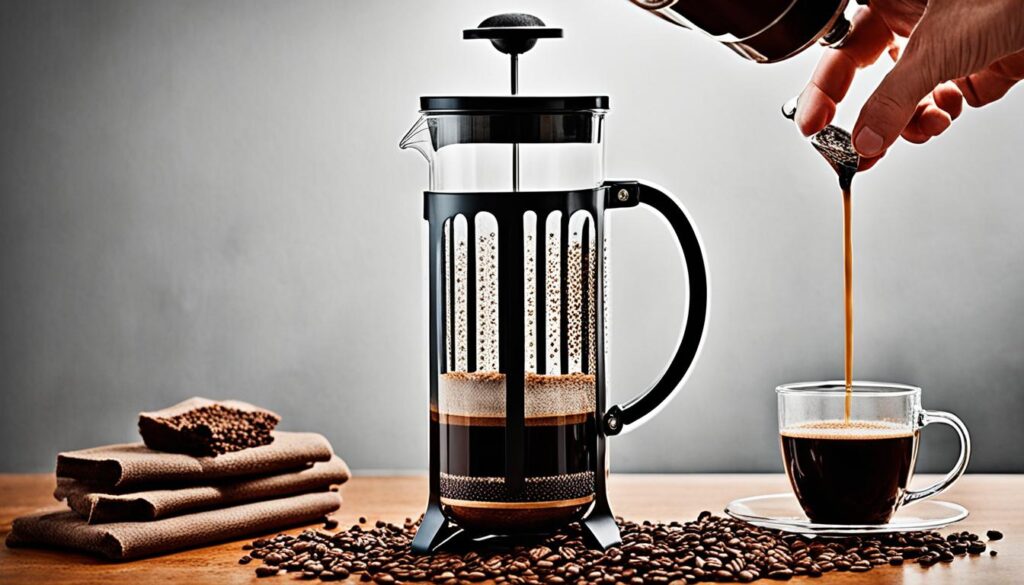
| Steps | Description |
|---|---|
| Step 1 | Heat water to around 200ºF. |
| Step 2 | Add coarse-ground coffee to the carafe. |
| Step 3 | Slowly pour the hot water over the coffee. |
| Step 4 | Allow the coffee to steep for four minutes. |
| Step 5 | Break the crust that forms on top using a wooden spoon. |
| Step 6 | Place the lid with the plunger on the carafe and steep for three more minutes. |
| Step 7 | Slowly push the plunger all the way down. |
| Step 8 | Serve the coffee immediately to prevent over-extraction. |
| Step 9 | Clean the French press after each use. |
The History of the French Press
The French press coffee maker, despite its name, actually originated in Milan, Italy over 80 years ago. The classic design of the French press has endured throughout the years and remains a beloved brewing method by coffee enthusiasts around the world. Its simple yet effective design allows for the extraction of rich, full-bodied flavors from coffee grounds, making it a popular choice for those seeking a flavorful cup of coffee.
The French press gained popularity due to its ability to produce a robust and aromatic brew without the need for any fancy equipment or electricity. All you need is hot water, ground coffee, and the French press itself. This simplicity, combined with the quality of the coffee it produces, has contributed to its enduring appeal.
“The French press is a timeless brewing method that brings out the true essence of coffee.” Olivia – Coffee aficionado
The French press has a long and fascinating history. Despite its Italian origins, the French press eventually gained popularity in France and became associated with the country. It is believed that the name “French press” may have originated from the French recognition and appreciation of this brewing method rather than its actual invention in France.
Over the years, the French press has remained largely unchanged in its design. It consists of a cylindrical carafe, a plunger, and a built-in filter that separates the coffee grounds from the brewed coffee. This simple yet effective design allows for a quick and easy brewing process that produces a rich and flavorful cup of coffee.
The French press has stood the test of time and continues to be a popular choice for coffee lovers who appreciate its simplicity, versatility, and the ability to customize their brew. Whether you prefer a bold and strong cup of coffee or a smooth and mellow one, the French press allows you to tailor your brew to your personal taste.
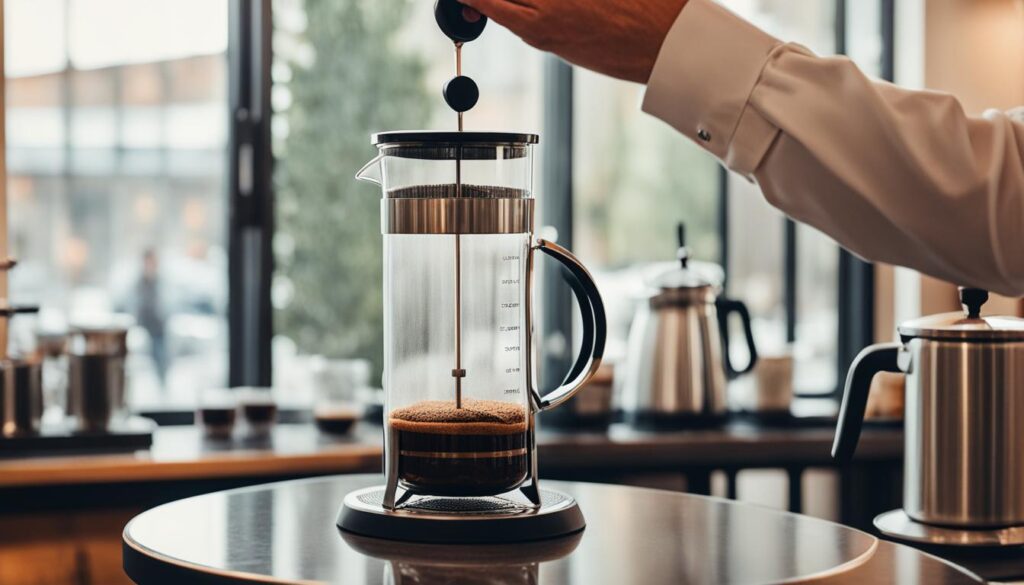
French Press Timeline
| Year | Event |
|---|---|
| 1929 | The French press coffee maker is patented in Milan, Italy. |
| 1950s | The French press gains popularity in France. |
| 1980s | The French press becomes a favorite brewing method among coffee enthusiasts worldwide. |
| Present | The French press remains a popular choice for its simplicity and ability to produce a flavorful cup of coffee. |
Tips for Using a French Press
When it comes to brewing the perfect cup of coffee with a French press, a few tips and techniques can make all the difference. Here are some suggestions to help you use a French press effectively:
- Use the correct coffee-to-water ratio for your desired strength. A general guideline is to use 1 tablespoon of coffee for every 4 ounces of water.
- Opt for filtered water to ensure the best taste in your coffee. Impurities in tap water can affect the flavor.
- Grind your coffee just before brewing for maximum freshness and flavor. Coarse grounds are ideal for French press coffee.
- Set the water temperature to the optimal brewing range of 195-205°F (90-96°C) using a thermometer. Water that is too hot can result in over-extraction and a bitter taste.
- Measure your coffee accurately using a scale or coffee scoop. Consistency in the amount of coffee will help maintain the intended flavor profile.
- Allow your coffee to steep for the recommended time. The ideal steeping time is around 4 minutes, but you can adjust it to suit your taste preferences.
- When pressing down the plunger, apply gentle and steady pressure. This helps to avoid grounds from getting into your coffee and ensures a smooth extraction.
- Serve your coffee immediately after brewing to prevent over-extraction. Leaving it in the French press for too long can result in a bitter taste.
- Thoroughly clean your French press after each use to remove any coffee residue. This will help maintain the quality of your brew and prevent any buildup that can affect future batches.
By following these tips, you can elevate your French press coffee brewing experience and enjoy a flavorful cup of coffee every time.

Expert Tip:
“To enhance your French press coffee experience, experiment with different coffee bean origins and roast levels. Each type of coffee offers unique flavors and aroma profiles that can elevate your brewing experience.”
Arf – Coffee Expert
Different Types of French Presses
French presses come in various designs and materials, offering coffee enthusiasts a range of options to suit their preferences and brewing needs. While the most commonly used type features a glass beaker with a metal plunger and filter, there are several other variations worth considering.
One popular option is the double-walled glass French press, which provides enhanced heat retention properties. The double-layered design helps keep the coffee hot for a longer period, allowing you to enjoy multiple cups without compromising on temperature.
For those seeking durability and long-lasting performance, stainless steel French presses are an excellent choice. They are resistant to breakage and are often more robust than their glass counterparts. Stainless steel French presses also offer superior insulation, maintaining the coffee’s temperature during the brewing process.
Ceramic French presses add an elegant touch to any coffee lover’s collection. Their aesthetic appeal and ability to retain heat make them a popular choice for those who value style and functionality. Ceramic French presses are also known for their durability and ability to create a smooth and consistent brew.
When selecting a French press, it’s crucial to consider your personal preferences and brewing requirements. Evaluate factors such as heat retention, durability, aesthetics, and even ease of cleaning. Moreover, ensure the quality of the materials used in the construction of the French press to guarantee a reliable and enjoyable coffee brewing experience.
Comparison of Different Types of French Presses
| French Press Type | Features | Advantages |
|---|---|---|
| Glass with metal plunger and filter | Traditional design, clear visibility of the brewing process | Classic look, affordable, easy to clean |
| Double-walled glass | Insulated design for improved heat retention | Keeps coffee hotter for longer, eliminates the need for a hot plate |
| Stainless steel | Durable construction, excellent heat retention | Long-lasting, resistant to breakage, retains coffee temperature |
| Ceramic | Elegant appearance, excellent heat retention | Aesthetic appeal, durable, creates a smooth brew |
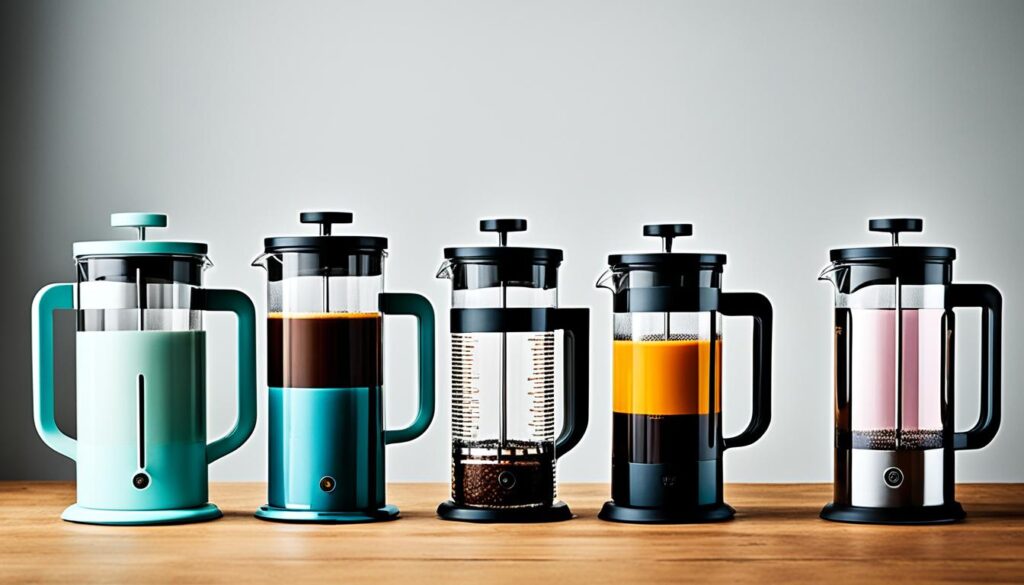
Choose a French press that suits your style, preferences, and brewing needs, allowing you to enjoy the perfect cup of coffee every time.
Safety and Health Considerations
When using a French press, it is important to prioritize safety and be aware of potential health concerns. By following a few safety tips and understanding the health considerations, you can enjoy your French press coffee with peace of mind.
Safety Tips for French Press
Here are some safety tips to follow when using a French press:
- Handle the hot water carefully to avoid burns. Use oven mitts or a towel to protect your hands.
- Ensure that the French press is placed on a stable surface to prevent accidental spills or tipping.
- Keep the French press out of reach of children to avoid any accidents.
- When plunging the coffee, apply gentle pressure to prevent hot liquid from splashing out.
- After use, allow the French press to cool down before cleaning.
By following these safety tips, you can minimize the risk of accidents and ensure a safe brewing experience.
Health Concerns with French Press Coffee
French press coffee may contain higher amounts of certain substances, such as cafestol and kahweol. These substances can impact cholesterol levels, which is a concern for some individuals.
However, it is important to note that research suggests moderation is key. Consuming French press coffee in moderation should not have a significant impact on cholesterol levels.
In addition, if you have specific health concerns or dietary restrictions, it is always a good idea to consult with a healthcare professional or nutritionist.
With these safety tips and health considerations in mind, you can enjoy your French press coffee responsibly and indulge in its rich flavor and aroma.
Common Mistakes to Avoid When Using a French Press
Despite its simplicity, using a French press to brew coffee can still lead to a few common mistakes that can impact the taste and quality of your brew. By being aware of these mistakes and avoiding them, you can ensure a better brewing experience and enjoy a more flavorful cup of coffee.
1. Using water that is too hot or too cold
The temperature of the water plays a crucial role in the extraction process. Using water that is too hot can result in over-extracted and bitter coffee, while water that is too cold may not extract enough flavor. To achieve the optimal brewing temperature of around 200ºF, it’s best to use a kettle with a built-in thermometer or measure the water temperature using a separate thermometer.
2. Using the wrong coffee-to-water ratio
Getting the coffee-to-water ratio right is essential for a well-balanced and flavorful cup of French press coffee. Using too much coffee can result in an overpowering taste, while using too little may lead to a weak and watery brew. A general guideline is to use a ratio of 1:15, which means one part coffee to 15 parts water. However, feel free to adjust this ratio based on your personal preference.
3. Using pre-ground coffee instead of freshly grinding the beans
Freshly grinding your coffee beans just before brewing is one of the keys to achieving a flavorful cup of coffee. Pre-ground coffee loses its freshness and flavor more rapidly, resulting in a less aromatic and vibrant brew. Invest in a quality coffee grinder and grind your beans just before brewing to get the best results.
4. Steeping the coffee for too long or too short a time
The steeping time determines the strength and flavor profile of your French press coffee. Steeping the coffee for too long can lead to over-extraction and a bitter taste, while steeping it for too short a time may result in a weak and underwhelming brew. Aim for a steeping time of about four minutes and adjust it slightly based on your taste preferences.
5. Plunging too quickly or forcefully
Plunging too quickly or applying too much force when pressing down the plunger can cause the coffee grounds to escape past the filter and end up in your cup. This can result in a gritty and unpleasant texture in your coffee. Take your time and apply gentle, even pressure when plunging to avoid this issue.
6. Not cleaning the French press properly after each use
Properly cleaning your French press after each use is crucial to maintain its performance and prevent any buildup of coffee oils and residue. Neglecting to clean it thoroughly can result in off-flavors and even mold growth. Disassemble the French press, rinse all the components, and wash them with soapy water. Ensure that you remove any coffee grounds or oils trapped in the filter and plunger to keep your French press in optimal condition.
By avoiding these common mistakes, you can elevate your French press brewing skills and enjoy a consistently delicious cup of coffee with each brew.
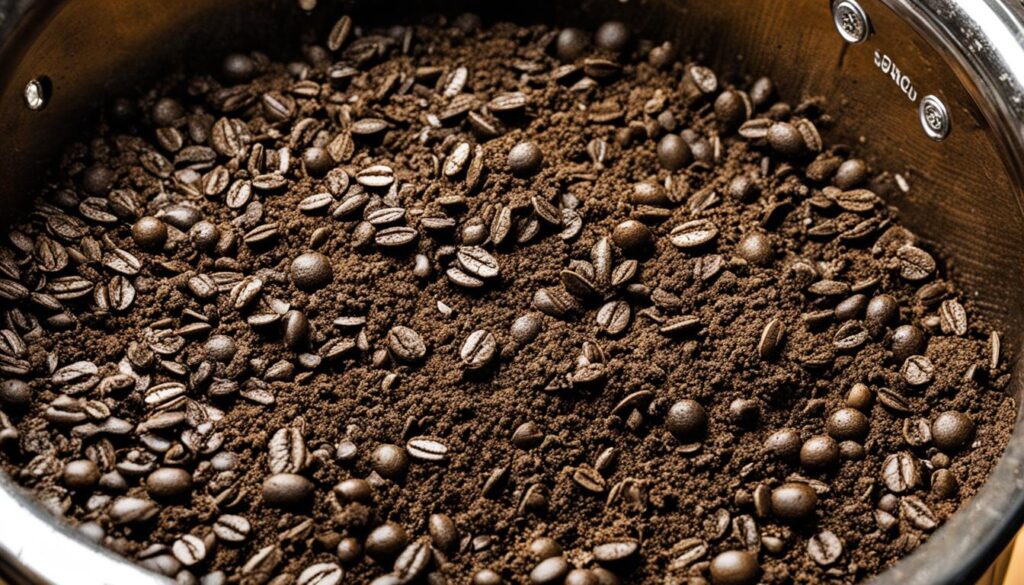
| Common Mistakes to Avoid | Effects |
|---|---|
| Using water that is too hot or too cold | Over-extracted or weak coffee |
| Using the wrong coffee-to-water ratio | Overpowering or weak brew |
| Using pre-ground coffee instead of freshly grinding the beans | Less aromatic and vibrant brew |
| Steeping the coffee for too long or too short a time | Bitter or underwhelming taste |
| Plunging too quickly or forcefully | Gritty texture in coffee |
| Not cleaning the French press properly after each use | Off-flavors and potential mold growth |
Conclusion
French press coffee makers provide a simple and straightforward method for brewing rich, full-flavored coffee. By following the proper steps and using high-quality ingredients, you can enjoy the unique taste and experience that a French press provides. With its robust flavor and creamy mouthfeel, French press brewing allows for the extraction of oils and sediment from the coffee grounds, creating a distinct cup of coffee. Additionally, French press coffee makers are a popular choice for coffee enthusiasts who appreciate the ritual and hands-on approach to brewing coffee. The immersion brewing process combined with the use of a metal mesh filter allows for a fuller extraction of the coffee’s flavors, resulting in a bolder and richer cup of coffee. This method of brewing has also been embraced by the specialty coffee industry, as it allows for aienhanced coffee production and a more pronounced flavor profile in the final cup.
When using a French press, it is important to consider the pros and cons, health considerations, and safety tips associated with this brewing method. While French press coffee offers a delightful taste, it may contain higher amounts of certain substances, such as cafestol and kahweol, which can impact cholesterol levels. However, research suggests that moderation is key, and consuming French press coffee in moderation should not significantly impact cholesterol levels.
Whether you are a coffee aficionado or simply looking to explore different brewing methods, incorporating a French press into your coffee routine can be a rewarding experience. It allows you to have control over the brewing process, experiment with different coffee beans, and savor the rich flavors of a truly handcrafted cup of coffee. So, why not give it a try and elevate your coffee brewing game with a French press?
